When Watford Women defeated Nottingham Forest Women in the Women’s National League play-off match at the end of May, there were high hopes among those connected with the club that they would be able to avoid an immediate return to the third tier and would instead start to establish themselves as mainstays in the Women’s Championship. However, things in that regard have not gone to plan, with Damon Lathrope’s team currently bottom of the table and with just one win to their name after 12 matches and only 10 still to play.
What has been clear, though, is that they are a much-improved team from the one that secured promotion ahead of the 2021/22 campaign, with their performances looking more assured. Their attack, in particular, has really allowed them to test their opponents. Unfortunately, the quality that they have shown at the top end of the field has not been matched by their defensive play, which is what is currently letting them down game after game. This tactical analysis will take a closer look at both sides of their performances to show what they are doing well and what they need to improve on in the new year.
Attacking threat
When looking back at Watford Women’s transfer business ahead of the 2023/24 season, it is clear that adding more goals to his side was a key priority for Lathrope, with him investing in all areas of the team but increasing the quality of his forward options as he tried to ensure that his team would be able to capitalise on those moments when they found themselves in promising positions.
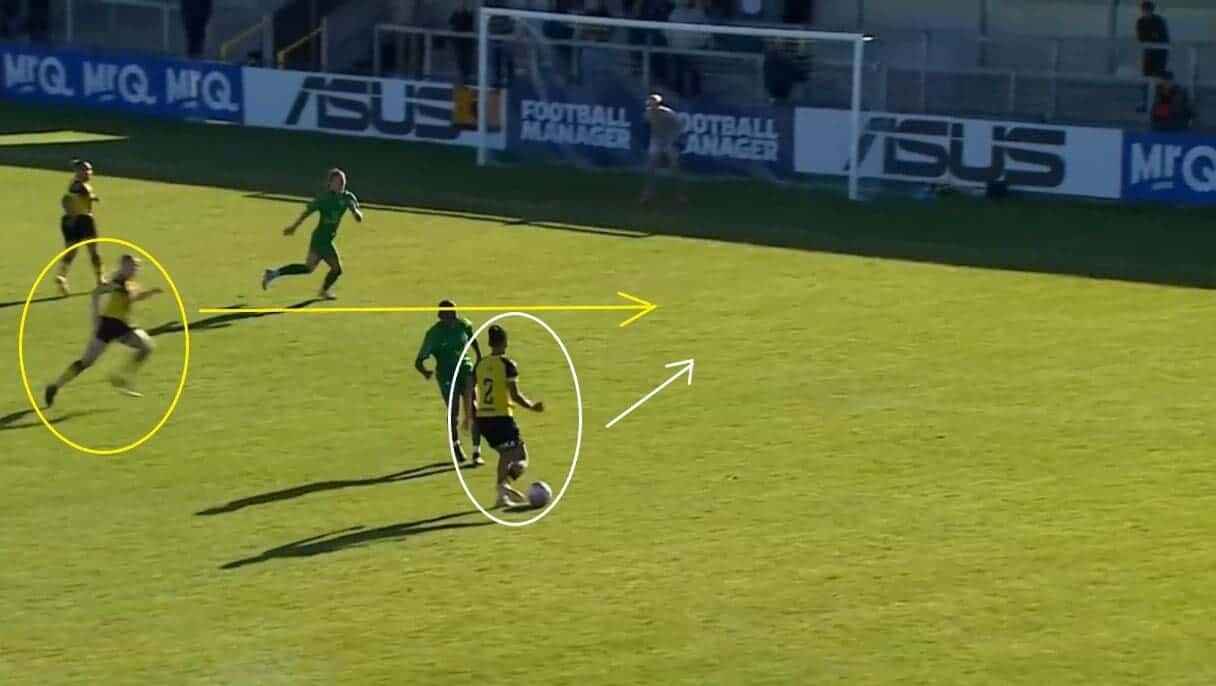
One player who has really made an impact at Grosvenor Vale (the home ground of Wealdstone FC) is striker Carly Johns, who joined from Oxford United Women (another team who went close to promotion last season) after netting 15 goals and finishing as the third tier’s highest scorer last season.
Whilst her goalscoring instincts have truly aided Watford’s bid for survival, it has been her movement and versatility that has stood out, with her not just capable of playing as an out-and-out striker but also dropping back and shifting wide in order to ensure that Watford can find the back of the net from all different angles and distances.
In this case, she has run across goal to get on the end of a pass from Dominican Republic and former Tottenham Hotspur Women right-back Lucía León, who was another summer arrival following a spell in Spain with Real Betis Féminas and who is looking to take Lewes Women’s Shauna Vassell out of the game here. On this occasion, the chance didn’t come off due to Grace Garrad making a vital interception, but the point still stands that Johns’ movement was key to the chance coming about.
Her ability to drift between channels has also benefitted Watford in other ways, with it allowing them to play her and other attackers on the field at the same time and to increase their goal threat without risking those at the top of the field getting in each other’s way. The weekend’s draw against London City Lionesses particularly demonstrated this, with Johns dropping back to help connect the play after coming on, whilst Michelle Agyemang, who joined in the summer on a dual contract with Arsenal Women and who started the match, tended to provide the focal point for the rest of the team to aim for.
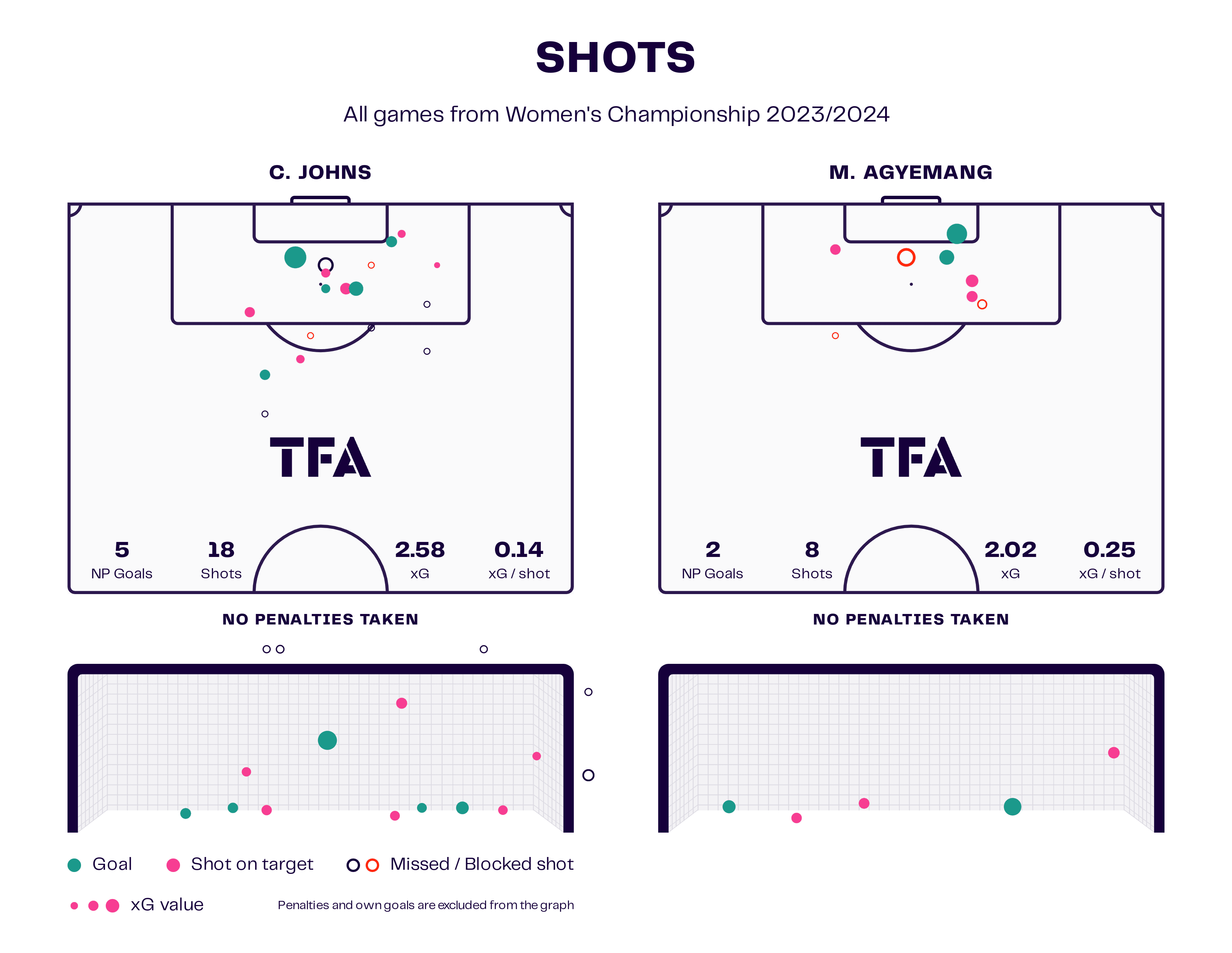
The difference between the two players tactically is highlighted in their shot maps, with Johns playing more matches, and so having more chances indicated, but the key thing is the variety of positions that she has taken them from, with all five of her goals so far being scored in very different ways.
When comparing that to Agyemang’s shot map, the Arsenal forward has scored her two goals so far (both of which came at the weekend) from the same area of the pitch, and that highlights how she is more of a poacher and is not someone who tends to move around as much as Johns does.
It is also worth noting that they are not the only goalscorers in the Watford squad, with the likes of Bianca Baptiste and the experienced Gemma Davison also among their options and spending time leading the line. Therefore, again, Watford have different profiles in the forward areas who all bring different things to the table, and it is that that has led to them averaging 1.14 goals per game and getting 40.9% of their shots on target to date.
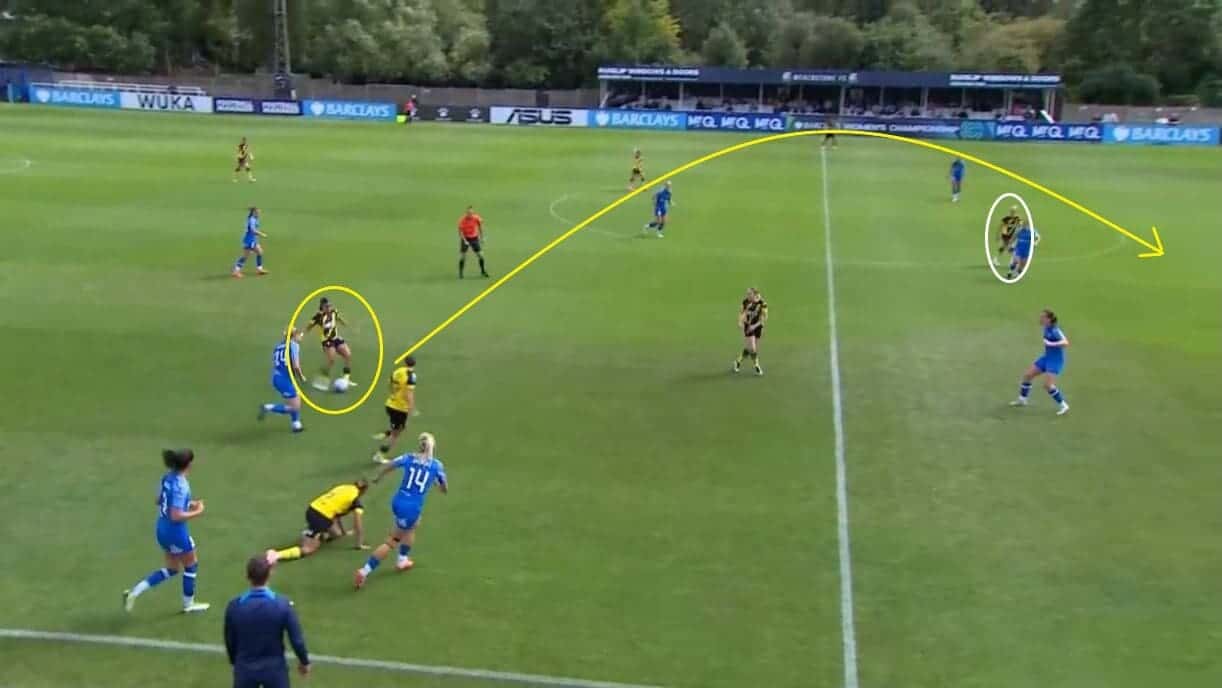
There is not only variety in their squad options but in their game plan too, with Watford’s tactics mainly revolving around progressing the ball through the thirds through well-constructed passing sequences but also consisting of more direct approaches too.
The games in which they opted to be more direct were when they were facing a side who played with a high back line. The season opener against Durham Women was one of those matches, with the defenders’ positioned around the halfway line here and Watford, therefore, having the opportunity to make quick breaks behind them.
In this case, Andria Georgiou has sent the ball forward, with Davison positioned on the shoulder of the back line and waiting for the ball to be sent in her direction. On this occasion, the chance doesn’t come off as Mollie Lambert, who has been one of the second tier’s best players so far, managed to get across and make a last-minute tackle, but the fact that 36.7% of Watford’s counterattacks so far have led to a shot on goal does highlight how dangerous they are when allowed to run free in territory such as this.

This is not to say that they have been perfect, though, and there have been some games when they have struggled to pose the same attacking threat. The trip to Reading Women, who were relegated from the WSL last season, was one of those when they didn’t play the same way, with them not looking to set up chances from the middle of the pitch as they have done in the majority of their matches and instead relying on crosses to transfer the ball into the goal area.
As a result, situations like this, when León is looking to take the ball beyond Rachel Dugdale and find a teammate inside her, were common to see in their play, and yet it didn’t work as it allowed Reading to sit back and to retain a compact shape as they focused on winning aerial battles and on continually repelling every delivery that Watford made.
It was a strange tactic to employ, given that Watford have only registered a 25.1% crossing accuracy this season, so it is clearly not their strength, and it led to them barely creating a single credible effort. It was definitely a case of points dropped rather than gained, given that playing in their usual manner might have led to Reading, who have been another of the league’s strugglers, potentially buckling under the constant pressure that Watford’s quick transitions can bring.
Build-up play
Whilst the way that Watford Women have used their attacking options has been really positive, what has been just as pleasing from their perspective is how they have moved the ball into their feet, with them controlling possession in many of their games (they have averaged 56.46% per outing so far) and always working as a team to ensure that opponents have as little chance as possible to regain it.
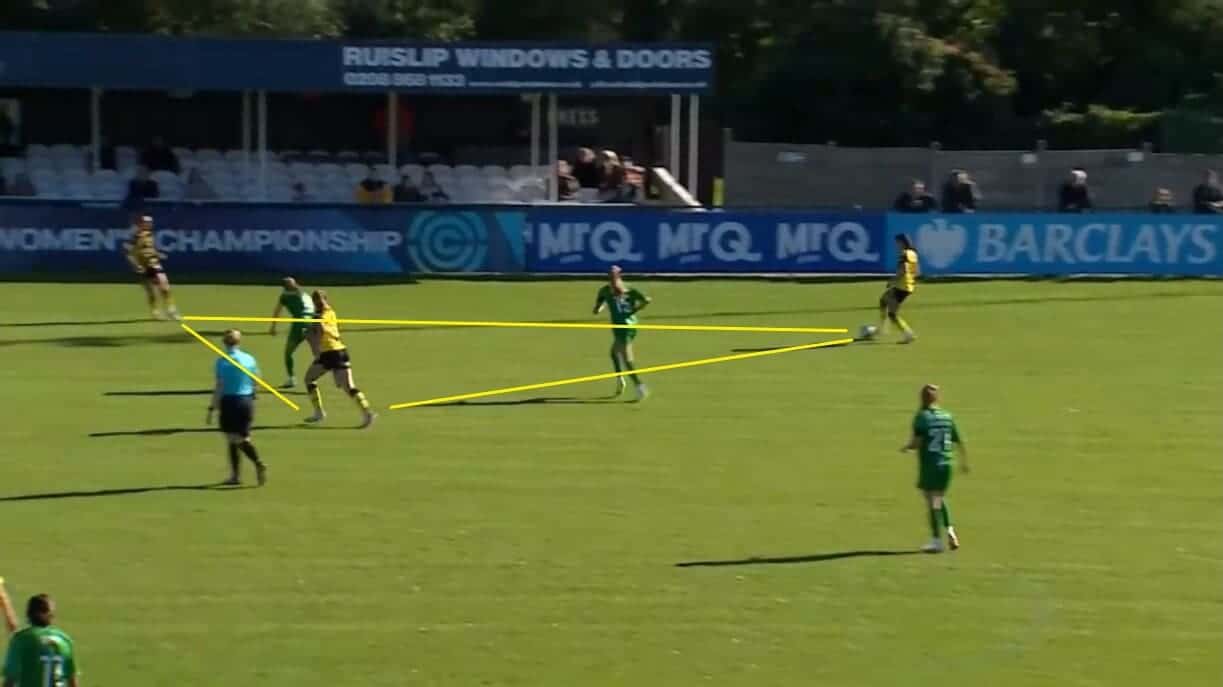
The primary method in which they have done this has been by forming triangles around the pitch and making series of one-touch passes wherever possible, and they have shown a capability to do this for long periods of play where necessary, meaning that it is effective both when facing opponents who have left themselves very open and when coming up against those who look to get numbers behind the ball.
It also shows that Watford can move up the field in different ways, with it already pointed out how they can be direct when there are chances for them to do so and that they do like to progress the ball through the thirds, and this highlights how effective they are at the latter and how they ensure that it is always difficult for their opponents to regain control of it.
On this occasion, Watford were able to manoeuvre themselves into a position from which they could send the ball into the path of Baptiste, who was leading the line for most of the match against Lewes. Even though she failed to find the target, the way that Watford found her is the key point here, and it is not hard to see why they have an 82% passing accuracy when looking at the composure that they constantly demonstrate in these phases of play.
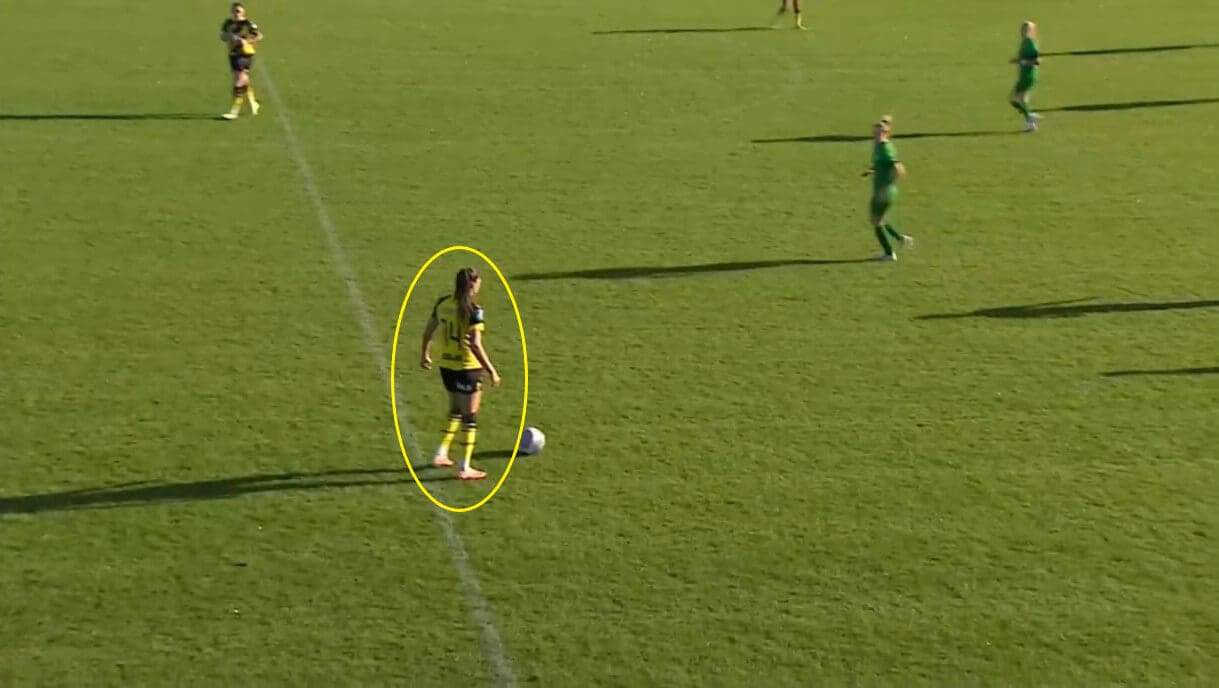
One player who has been vital to the success of these transitions is defender Harley Bennett; she is an experienced operator and has played in many different styles during her career. For Watford, she has predominantly been deployed on the right-hand side of the back three, with the idea being that she can then use her ball-playing qualities to launch attacks from the back and to give her team something to build from when looking to make those quick passes.
There is no doubt when looking at her contributions that she has been a key reason for Watford’s overall success in moving the ball from front to back. It has not only been inside her own third that she has connected with those ahead of her as she has also been known to run forward and to act as an additional midfielder when needed, again increasing the overall accuracy of Watford’s transitions.
This particular situation sees her searching for a teammate ahead of her and trying to continue what was a long period of possession for the league strugglers, with Lewes holding firm and working hard to limit their options. However, with Bennett in the side, Watford did manage to break them down and to get a shot away at goal. So the fact that they have defenders who can add these qualities to their build-up play really demonstrates how their positive moments are down to the whole team working together to achieve a joint goal.
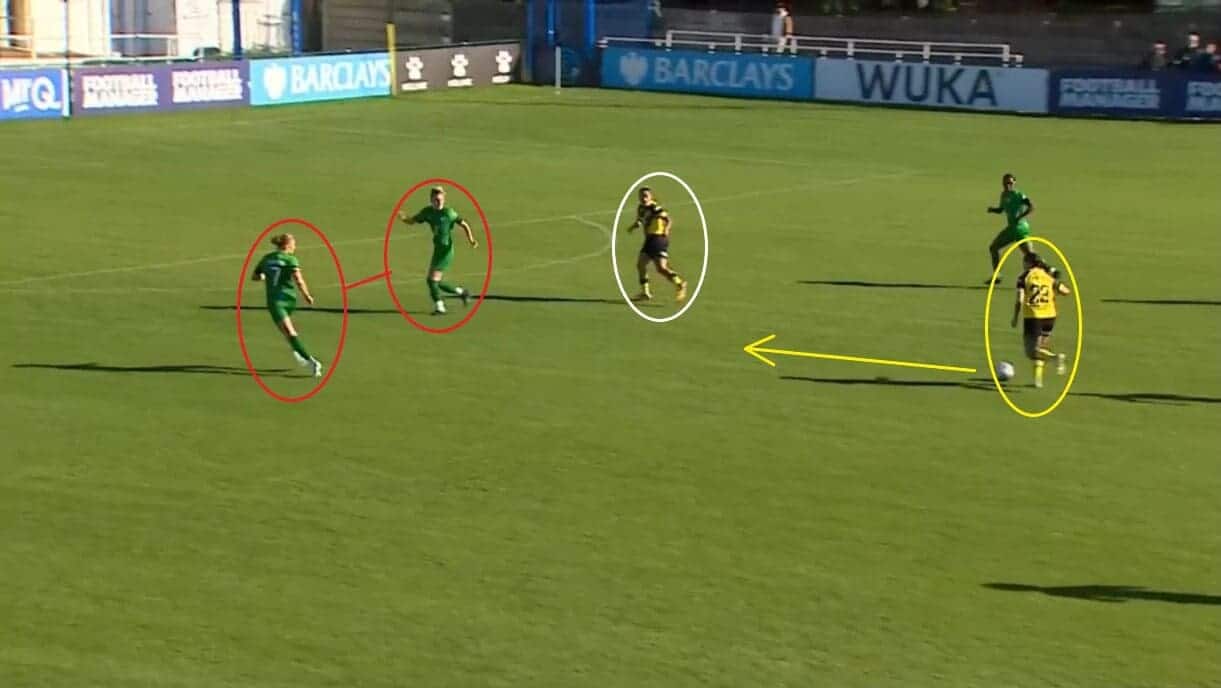
However, not all of Watford’s build-up play has been centred around constant pass-and-move phases, which is important as it shows how they have different game plans to fall back on should their original tactics fail to have the desired effect. In this case, it is not down to an issue with the main game plan that has led to Coral-Jade Haines dribbling forward on her own, but simply that the space ahead of her has opened up. The invitation is there for her to attack forwards and to get into an area from which she can try her luck at goal.
With Lewes being the other side at serious risk of relegation this season, with them sitting one place above Watford at the time of writing after picking up just two wins so far, Watford knew that they would not be the most secure team defensively and that opportunities like this would be common as the game went on. Therefore, again, it is about adapting to different circumstances and having multiple ways of playing, and Watford, in possession, have demonstrated that they have the ability to change things around as needed, meaning that they will always have a chance of winning matches.
Defensive problems
The theme of teamwork and unity has been prominent throughout this analysis so far, but that, unfortunately, doesn’t continue when looking at Watford Women’s defensive play, with it abundantly clear to anyone who has watched them this season that, for all of their positivity in attack, they are being continually let down by what they do as soon as the ball has been lost.
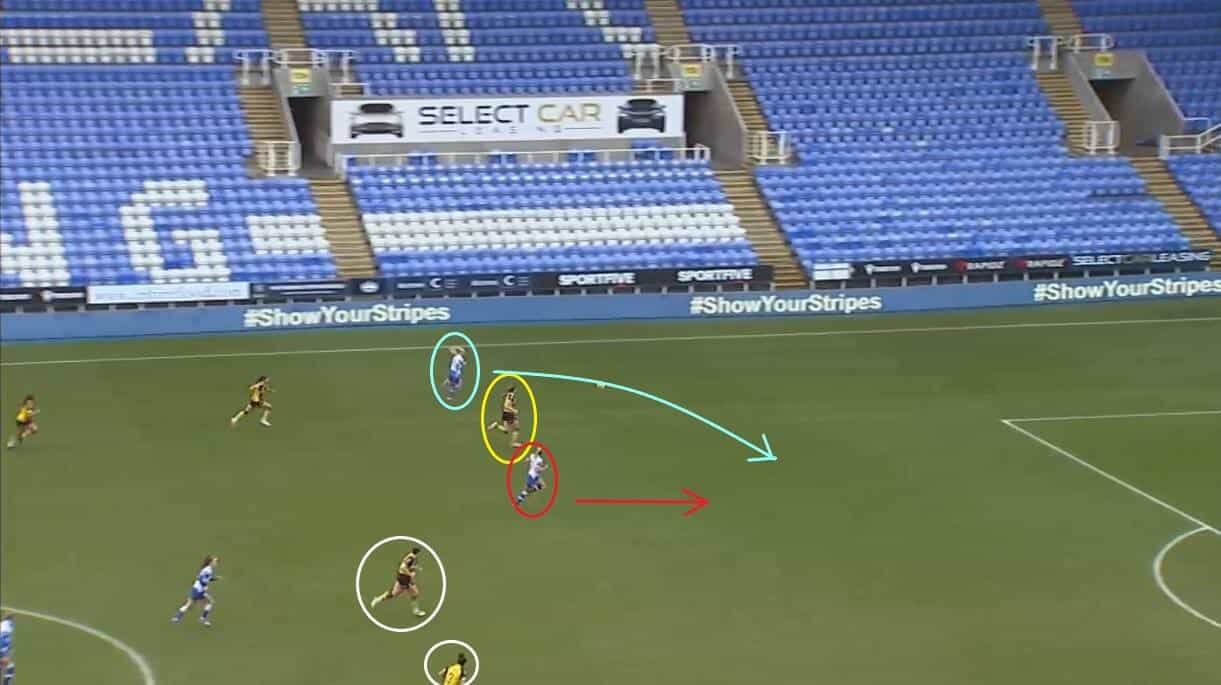
The critical issue surrounding this side of their performances is that the partnerships that are established whenever they have the ball have tended to disintegrate, with the backline particularly guilty of this as they transform into a group of individuals and lack the coherence that they show in other moments of the game.
This is demonstrated clearly here, with Reading looking to get behind them and sending the ball forward for on-loan Aston Villa Women forward Freya Gregory to get on the end of, and Corinne Henson has reacted to the danger here and has worked hard to move towards Gregory and to prevent her from shifting the ball into the middle.
However, she is only one player. With former Celtic Women striker Charlie Wellings inside her and giving Gregory an easy passing option in open space, she needs support from those around her to bring this attack to an end. Unfortunately, the urgency that she displayed was not replicated by Megan Chandler or Abbie Lafayette, with both only starting to move back once the ball was at Gregory’s feet. By that stage, though, it was too late for them to get back in time as Wellings had already accessed the space behind them, and the result here was that she was able to receive the pass and get a shot away at goal.
On this occasion, Watford were let off due to Wellings not connecting with the ball as she would have wanted to, but the fact that 47.2% of shots against them have been on target does show that this is a big issue that they need to be aware of, with it not being the first time that they have allowed their opponents to get behind them with this much ease.
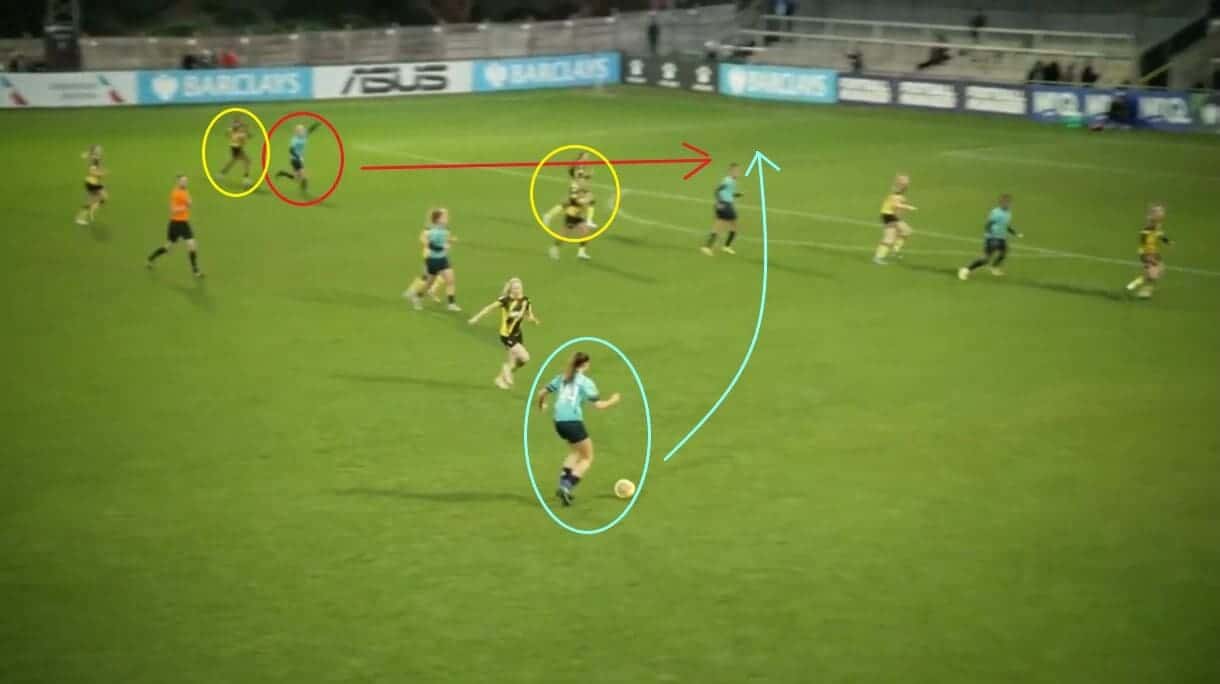
The lack of communication and organisation in their defensive play is also evident in other ways, with it being something that has really blighted them as the campaign continues. Against London City, they started really positively and scored three goals to take a commanding lead heading towards the break, and it looked as if they would finally secure a second win of the season and a much-needed three points.
However, as the game went on, they reverted to type without the ball and started to leave bigger gaps open as they invited London City in, and they can only have themselves to blame for their opponents’ comeback to secure a draw for that reason.
Those vast spaces in their defensive shape are evident here, with Watford needing to stay compact at this stage and to just see the game out, given that it was 3-2 in their favour with just minutes to go. However, León and Bennett have not realised where each other is until it is too late, with Grace Jarrett sending the ball through and Lucy Fitzgerald running from the wing to put it into the back of the net.
It wasn’t a simple goal to score, with the pressure on it from London City’s point of view meaning that there was every chance of the effort lacking power or direction, but they made it and, again, Watford will know that they could have avoided it had they retained their shape and not left so much space open in their defensive line.
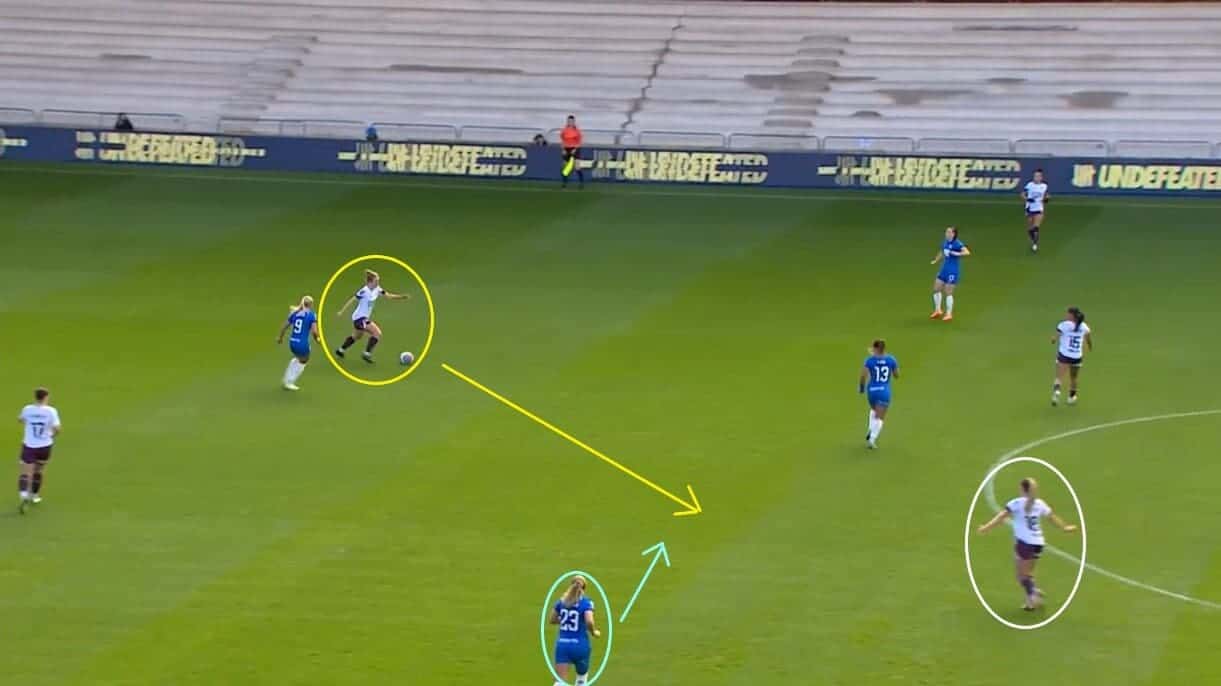
It’s not only team mistakes that have been their bane, though, with individual errors also continually present in their play. They endured a particularly frustrating day at St. Andrews, with Birmingham City Women scoring five times and winning fairly comprehensively in the end, and yet moments like this, when Anne Meiwald didn’t look before passing and so gave the ball to Charlie Devlin instead of teammate Laila Harbert, meant that they again only needed to look at themselves to work out what had gone so wrong.
The Championship is a very tough league to win games in, as any coach or player who has experienced it can attest to, and any team that wants to gain victories needs to avoid gifting their opponents opportunities to break them down. Watford will, therefore, really need to improve on this side of their play if they are to leave themselves any chance of staying up when the league resumes after the Christmas break because it is difficult to see them achieving that after some of the performances without the ball that they have put on so far.
Conclusion
In conclusion, this tactical analysis has looked in detail at Watford Women, who were promoted back to the Championship last season but who have struggled to compete in the second tier so far, with them seemingly destined for an immediate return to the National League.
Not all hope is lost, though, with the scout report highlighting how their attacking play has looked vastly improved from the last time that they were in this division, and that, combined with their positive build-up play, will always give them a chance of gaining the points that they need to secure survival.
However, football is a game where attack and defence need to match each other in quality, and Watford don’t have that balance at this moment in time. Therefore, there is a lot of work for Lathrope and his players to do on the training ground ahead of their next match because 10 matches is a lot. Still, a few poor defeats here and there could jeopardise their hopes of staying up, and they will need to make a fast start when matches resume if they are to show what they are made of and prove to their doubters that they can avoid a return to the National League.





Comments